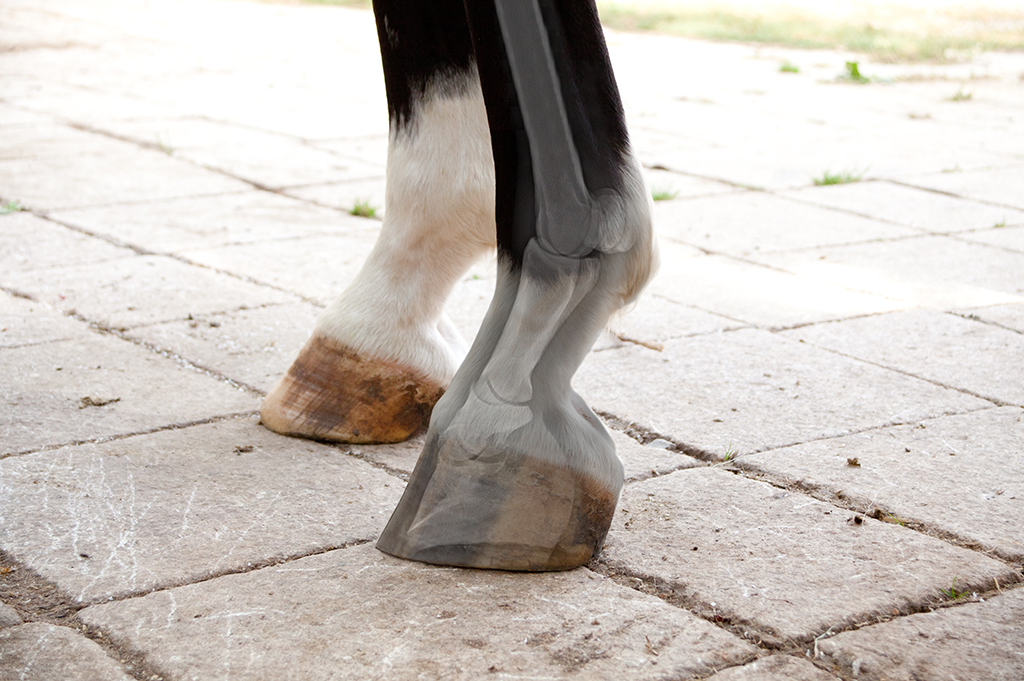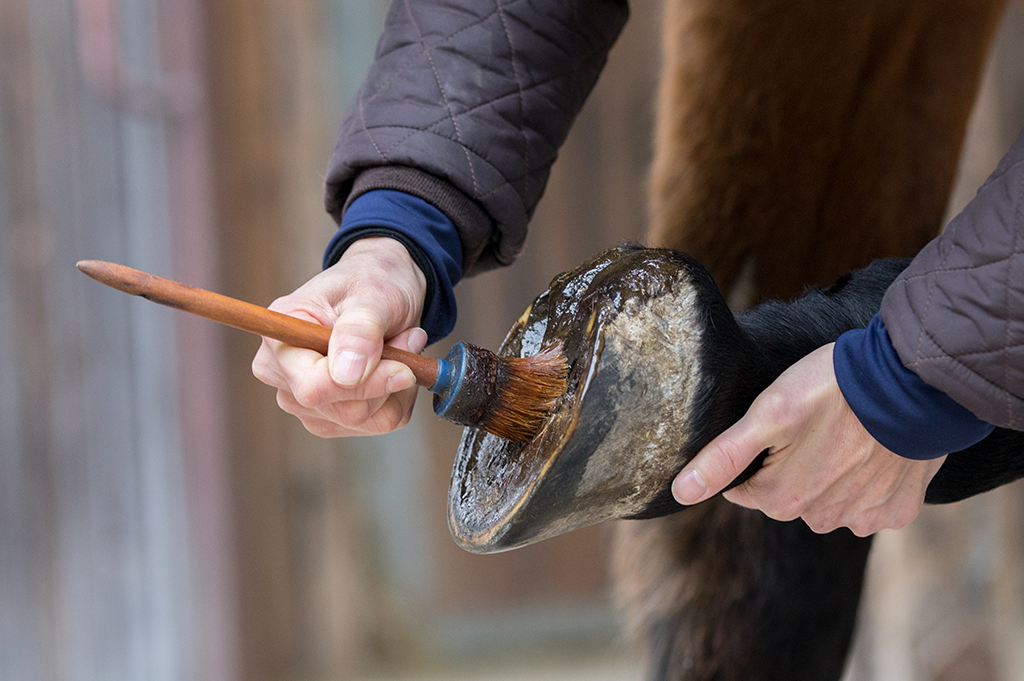
Vets across the country are frequently asked “what could I have done to prevent my horse from developing laminitis?” With studies suggesting that 1 in 10 horses/ponies are affected by laminitis each year, it can be a challenging condition, which in many circumstances could have been prevented.
Laminitis can have profound health implications for your horse and if not spotted early, it could lead to serious issues down the line. The severity of laminitis can vary however, in worst case scenarios, some horses may need to be euthanised as the pain from laminitis is no longer manageable.
It can be difficult to observe laminitis in horses, especially if you don’t know what to watch out for. Check out this helpful laminitis guide, which is intended to assist you in understanding, preventing, spotting, and treating laminitis in horses and ponies.
What is laminitis?
In general terms, laminitis is where your horses’ hooves become inflamed.
The hoof comprises of two layers; The first is the horn which is the external insensitive layer and the second is the laminae which is the internal sensitive layer.
When the interlocking laminae, which suspend the coffin bone within the hoof wall become inflamed or damaged, laminitis occurs. Laminitis can become very painful (especially when left untreated) and can result in lameness in extreme circumstances.
A variety of scenarios are known to cause laminitis and there are cases where the pain has become so severe, that it can no longer be managed, meaning the horse needs to be euthanised.
What causes it?
There are certain events that are known to trigger equine laminitis. Here are some common examples:
- Diet change – your horse has experienced an abrupt change in its diet.
- Illness – your horse has suffered from illness or high fever.
- Injury – due to injury, there is disproportionate weight bearing on one of your horse’s legs.
- Endocrine disorders – your horse suffers from pituitary pars intermedia dysfunction or equine metabolic syndrome. These disorders are known to make horses or ponies more prone to laminitis and may even be the sole cause of it in some cases.
The following factors can also make your horse more susceptible to laminitis:
- Obesity – your horse is overweight.
- Heavy breeds – if your horse is a heavy breed, it can be more likely to develop laminitis.
- Bingeing – your horse has been allowed to binge on grain.
- Previous laminitis history – your horse has previously had laminitis and therefore, is more likely to suffer from it going forward.
As there are so many causes of laminitis, you should not feel ashamed if your horse goes on to develop it. If you suspect your horse is suffering from laminitis or if you are worried, you must contact your vet immediately. Treatment is often more effective when the early signs of laminitis are spotted.
What are the symptoms?
It is important that you can spot the clinical symptoms of laminitis in your horses.
Some of the symptoms can include:
- A strong / bounding digital pulse – place your hand down the side of your horse’s lower limb where the digital artery runs through the groove. You should be able to feel the pulse where the artery runs down the back of the fetlock. Normally this should be faint or absent but in a laminitic horse it’ll be “bounding”.
- A hot hoof – if the hoof is hot for hours, it can be a sign that the horse is getting laminitis.
- Divergent hoof growth rings – horses with mild laminitis may not become lame however, they will develop growth hoof rings which are wider or lower at the heel.
- Weight shifting – your horse is shifting its weight about three to five times per minute. If their feet are very painful, they may shift their weight back to their haunches.
- Shortened stride – know your horse’s stride. Have strides become shorter? If so, your horse may be suffering from laminitis.
- Reluctance to turn – a reluctance to turn can also be a sign that your horse has laminitis. This can range from your horse pinning its ears to simply refusing to move.
If your horse is displaying any of the above symptoms, then you should get in touch with a veterinary specialist immediately.

How is it diagnosed?
Equine laminitis can be split into three categories: subclinical laminitis, acute laminitis, and chronic laminitis. Each type of laminitis will display varied symptoms.
- Subclinical laminitis is noted when there are minor hoof changes. Your horse may or may not show subtle signs.
- Acute laminitis typically comes on very quickly. It can be extremely severe and usually your horse will not want to move or get up.
- Chronic laminitis will present more ongoing symptoms. Often, your horse will have experienced prior laminitis episodes, causing hoof changes or a movement in the pedal bone.
Depending on the severity of the symptoms, your veterinarian may wish to take X-rays of your horses’ feet to decide on the best diagnosis and treatment.
How is it treated?
Your vet will be able to advise on what is best for your horse depending on if they are suffering from mild or chronic laminitis, however, here are some common treatments:
- If your horse has developed laminitis due to overfeeding, it is advised that you consider removing the food source immediately. Your horse will need to be put on a special diet, which should be discussed with your vet.
- You may be required to continuously monitor your horses’ weight especially if the laminitis was triggered by your horse being overweight in the first place.
- Hoof care is critical, and your farrier should be consulting your vet for the best course of treatment.
- Your vet may recommend medicine to control the pain in laminitic hooves.
- You can also consider foot support and box rest.
Do not start any form of treatment without consulting your vet.
What can you do to help a horse with laminitis?
The key to helping your horse combat laminitis is an early diagnosis and a headfirst approach to treatment. Here are a few ways you can support a horse with laminitis.
First, make sure that your horse is relocated to a smaller pen / stable and then use bedding such as shavings, cardboard, or sand, which can mould around your horse’s hoof. Sand can be difficult to manage in a barn environment, so, horse specialists recommend that you put it where your horse is most likely to stand, bedding can be placed in the other areas of the barn.
Second, follow the advice from your vet on feeding your horse. They will recommend the most suitable diet. However, it is often advised that you avoid hays that are high in sugar such as ryegrass hay or oat hay. Instead, feed your horse hay that is low in sugar such as mature or stemmy lucerne hay and mature or stemmy tropical grass hay.
Third, make sure your horse is comfortable. It may even help to have a companion nearby, so your horse doesn’t get stressed or lonely.
And finally, don’t be tempted to use a hose to cool your horses’ hooves as this can make the laminitis worse in the long run.
Before you make any changes to your horse’s environment, please consult a vet who will be best placed to advise on these modifications. You do not want to do anything that is going to stress your horse further so each change should be following professional advice.
What is the prognosis for a horse with laminitis?
The prognosis for a horse suffering from laminitis can vary. If the coffin bone is not replaced, your horse may recover. The more progressed the laminitis is, the more likely that recovery will be lengthy, with an uncertain outcome.
Some horses do have to be euthanised if pain cannot be managed effectively. The earlier laminitis is identified, the higher chance of recovery for your horse.
Is there any way of preventing it?
Here are some simple tips you can follow to prevent laminitis:
Watch your horse’s weight: Keep a close eye on your horse’s weight. Use a weigh tape and fat score your horse on a regular basis.
Limit grazing: In a horse’s diet, grass is often the main source of calories. Restrict intake by using a grazing muzzle, electric fencing, or an alternative grazing system.
Let your horse stay warm naturally: If your horse is overweight, winter can be a great opportunity to help it lose that excess fat. Consider when it really needs to be rugged and whether there are times when it can be un-rugged. When the horses’ body is not covered, it’ll be forced to burn more calories to keep warm.
Make feeding time interesting: Consider using trickle feeders or hay balls to increase enrichment and reduce the consumption rate. This will also increase the chance of your horse moving around rather than stationary feeding.
Spot laminitis: If you suspect your horse has laminitis, contact your vet immediately. Remember, the earlier you spot it, the more likely you will be able to manage the condition.
Conclusion
It is important to seek advice from your vet if you believe that your horse may have laminitis. Frequent visits from the farrier may help, as they can address and identify any early signs of issues.
Having horse insurance could allow you to cope financially should your horse develop a serious health condition in the future. Check out our horse insurance page to get a quote.
Blog was originally written in 2019 and has been updated in line with current practices as of 2021. All content provided on this blog is for informational purposes only. We make no representations as to the accuracy or completeness of any information on this site or found by following any link on this site. We will not be liable for any errors or omissions in this information nor for the availability of this information. We will not be liable for any loss, injury or damage arising from the display or use of this information. This policy is subject to change at any time.


